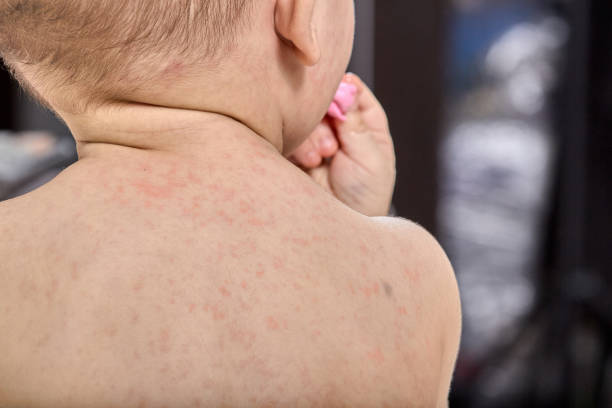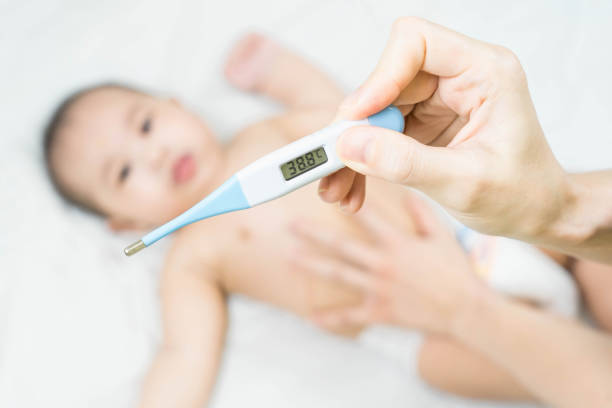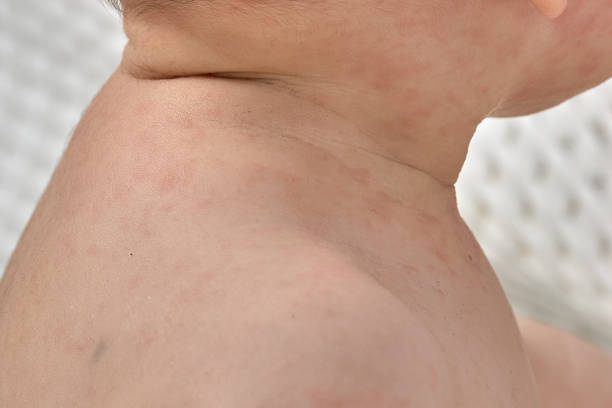Is roseola in babies serious? How does a child get roseola infantum? What does roseola rash look like? How do you treat roseola in children?
Infants and young children are most commonly affected by the viral infection Roseola. Children who are infected typically experience a high temperature followed by the appearance of a rash. Let us learn more about this type of viral infection in this article.
Roseola
This virus, also known as Roseola Infantum, commonly affects young children under the age of two. Most of the time, there is no need for concern, and children recover on their own. Another name for it is the sixth sickness or sixth disease.
High fever, cold-like symptoms, and occasionally a stomach rash are all indications of roseola. This contagious sickness, which primarily affects infants and toddlers, is brought on by the human herpes virus (HHV) type 6. Having had the sickness as a child often makes adults immune. Without medical intervention, the virus disappears in approximately a week.

Image source: iStock
What causes Roseola?
Human herpesvirus 6 or, in rare cases, human herpesvirus 7 is the cause of the infection. Although it is still present in the child’s body, it normally remains dormant or switched off.
Infants and young kids between the ages of 6 and 24 months are the most vulnerable to Roseola Infantum.
How did my child get roseola?
Droplets and respiratory secretions are how the roseola virus spreads. It can quickly spread through daycare facilities and towns before anybody even realizes the child is ill because it is contagious before the rash shows.
Your baby is likely to catch the infection if she is close to an infected child who sneezes. She can potentially contract it by exchanging eating utensils with an infected acquaintance or by chewing on a toy that has already been chewed on.
After exposure, it may take several days for symptoms to appear, including a high fever, which is followed by the characteristic rash. Once a child recovers from roseola, they are usually immune to future infections.
Roseola Rash after fever
A kid who gets the virus that causes roseola may not manifest any symptoms for 5 to 15 days. The first sign you’ll notice when it does is a sudden, high fever (above 103 F) that lasts for 3 to 7 days or can come and go.
Your youngster may appear to be healthy aside from the fever. They might be agitated or restless. They might also get a raised, spotted, reddish rash when the fever goes away, mostly on their neck and torso. It may only last a few hours or a few days, and it doesn’t itch.
Roseola Symptoms
It will probably take 1 to 2 weeks for symptoms of illness to show if your child is exposed to someone who has roseola and contracts the virus. They can also not show up at all.

Image source: iStock
A high temperature (typically exceeding 103° F or 39.5° C) is the initial symptom of an illness. Three to seven days may pass before this fever breaks. A rash that may spread to their back, neck, and arms commonly develops on their stomach after the fever has subsided. It does not itch or hurt and is made up of pink or red patches.
The rash may persist for one to two days but can disappear after a few hours.
Additionally, children with roseola infantum may experience cold or flu-like symptoms, such as:
- A stuffy nose
- Irritability
- A little cough
- A sore throat
- Lymph node swelling
- Diarrhea or an upset stomach
- A decrease in appetite
- Inflamed eyelids
- Seizure. This typically results in a febrile seizure or a seizure triggered by a sharp increase in body temperature. Rarely are seizures of this kind hazardous. However, if you think your child has had a seizure, you should call your doctor or go to the hospital right away.
What does roseola rash look like?
The roseola rash is one of the hallmark features of this viral infection. It typically appears after the fever subsides, usually around the third to fifth day of illness.
The rash is characterized by small, pink, or red spots or bumps that may be flat or slightly raised. These spots are usually concentrated on the trunk and may spread to the arms, legs, neck, and face. The rash is not typically itchy or painful and usually lasts for just a day or two.
Is roseola in babies serious?
Roseola, also known as roseola infantum, is generally not considered a serious illness in babies. It is a common viral infection that primarily affects infants and toddlers. While it can cause a high fever and a distinctive rash, most children recover without any specific treatment within a week.
What issues could it lead to?
However, in rare cases, complications can occur, such as febrile seizures, which can be alarming but are typically not associated with long-term harm.
Seizures can be brought on by very high fevers. If this occurs to your child, they could briefly lose consciousness. For several seconds or even minutes, their arms and legs may jerk. They might also become unable to regulate their bowels and bladder.
Call 911 if your child is having a seizure. Fortunately, most seizures in young infants are brief and harmless.
Is roseola contagious to adults?
Roseola is primarily contagious to infants and young children. It is caused by human herpesvirus 6 (HHV-6) and sometimes human herpesvirus 7 (HHV-7). Once a child has been infected and recovers, they are generally immune to further infections.
While it’s less common for adults to contract roseola, it is theoretically possible, especially if they have not been previously exposed to the virus. The transmission is typically through respiratory secretions, so close contact with an infected child is the most common route of transmission.
Roseola vs. Measles
Roseola, also known as roseola infantum, sixth disease, or exanthema subitum, is a viral infection that causes rashes and fever in babies ages 0 to 12 months. It is caused by the human herpesvirus 6 or 7. It is spread through tiny air droplets that people can breathe in (when an infected person sneezes or coughs) or through the surfaces they touch.
Meanwhile, measles, or rubeola, is a widespread viral disease that is common among children ages 0 to 5. Common symptoms of this disease are high fever and rashes. People who are infected with the virus can spread this through direct contact and the air.
These two viral illnesses affect the same age group and present the same signs and symptoms, which is why they are often confused as one or the other. However, there are several ways to differentiate measles from roseola.

Image Source: iStock
For one, if you look very closely, roseola rash is usually more pink-red, while measles rash is more red-brown.
Moreover, the rash from roseola begins in the torso and spreads out, while the measles rash is likened to paint dripping – it starts on the face and moves downwards.
Finally, children with roseola can appear well (some don’t even get rashes) apart from the high fever, while those with measles typically look and behave as if they are unwell.
If you are unsure whether your child has measles or roseola, it’s best to consult the pediatrician for an accurate diagnosis.
Testing for Roseola
Do newborns undergo any testing to check for roseola?
Yes, although they are typically not required. Roseola is a mild illness that usually goes away on its own, but your baby’s doctor can take some blood to screen for roseola antibodies, which indicate she is infected.
However, the inconvenience is typically not worth it. The majority of the time, the doctor will base the diagnosis on your child’s medical history. (A three-day fever followed by a rash is most likely roseola.)
How long does Roseola rash last?

Image source: iStock
Roseola typically lasts four days and hardly ever necessitates medical attention. The majority of symptoms are so mild that parents frequently are unaware that their child has the virus.
Can you have roseola and not even realize it?
It’s very possible that you or your child unknowingly carried the virus that causes roseola. There are numerous causes of fever in children.
Two-thirds of children do not develop a roseola rash, so you can mistake your child’s fever for another sickness and never realize that they have had roseola.
How is Roseola Treated or Managed?
How do you treat roseola in children?
There is no specific antiviral medication for roseola, and treatment primarily focuses on managing the child’s symptoms.
As the infection progresses, roseola symptoms normally go away on their own in about a week. Your child’s doctor could advise giving him or her acetaminophen or ibuprofen to reduce the temperature. The rash doesn’t itch or hurt, so you shouldn’t need to treat it. Children with compromised immune systems might benefit from taking antiviral drugs.
Roseola is contagious for how long?
Your doctor will advise you to keep your child away from other people while they are sick with roseola, at least until their fever subsides. Even if they still have a rash, they can play with other kids once it has subsided for at least 24 hours.
My child has roseola. Should they skip daycare for now?
Kids with roseola can pass on the virus to others before they even show symptoms. But once you know they’ve got roseola, they won’t spread it anymore.
If your little one’s feeling just fine, and their symptoms are mild, you can probably send them to daycare. But if they’ve got a fever and aren’t feeling great, it’s a good idea to let them stay home, so they can take it easy and get better.
How can I protect my child from Roseola?
Keep her away from adults and children who are ill. If the other mum phones to say that her child has a fever but is otherwise healthy for their playdate, cancel the playdate. Roseola (and a tonne of other illnesses!) can be avoided by constantly washing hands and toys and by forbidding the sharing of cups and eating utensils.
No vaccination exists to protect against roseola. The best way to prevent people from contracting the virus is through good hygiene. Infection risk can be decreased by:
- Refraining from making intimate contact with contagious people.
- Sneezing and coughing into the bend of the elbow.
- Frequent hand washing and the use of hand sanitizers.
Most kids who have roseola recover without experiencing any long-term health problems. Pneumonia and other consequences may be a risk for kids whose immune systems have been compromised by cancer, autoimmune illness, or other diseases. Children who have the virus develop an immunity to it, making them less likely to contract it again.
Here at theAsianparent Philippines, it’s important for us to give information that is correct, significant, and timely. But this doesn’t serve as an alternative for medical advice or medical treatment. theAsianparent Philippines is not responsible for those that would choose to drink medicines based on information from our website. If you have any doubts, we recommend consulting your doctor for clearer information.